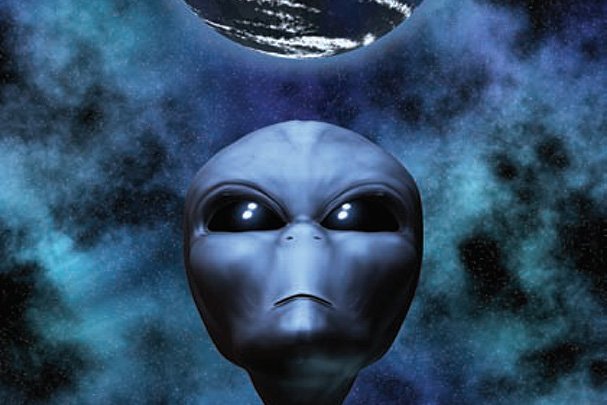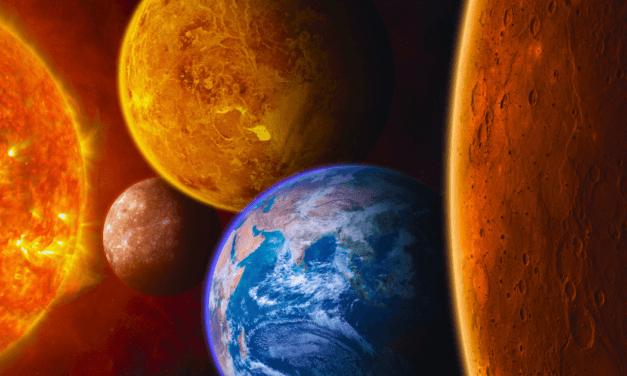This article first appeared in the CHRISTIAN RESEARCH JOURNAL, volume 35, number 01 (2012). The full text of this article in PDF format can be obtained by clicking here. For further information or to subscribe to the CHRISTIAN RESEARCH JOURNAL go to: http://www.equip.org/christian-research-journal/
On February 1, 2011, NASA’s Kepler mission team announced that they had discovered 1,235 candidate planets orbiting other stars (exoplanets). Launched on March 6, 2009, the Kepler mission’s primary science objective is to determine the fraction of Earth-size planets that orbit within the circumstellar habitable zones (CHZs) of their host stars. A terrestrial planet within the CHZ can maintain liquid surface water, a prerequisite for life.
Kepler searches for planets using the photometric transit method, whereby a star dims slightly as a planet crosses between us and the star. This method has been employed successfully with small ground-based telescopes since 1999, but the Kepler telescope is much more sensitive thanks to its location outside Earth’s atmosphere.
What made this announcement truly historic was the discovery of three to six exoplanet candidates less than twice the size of Earth within the CHZs of their host stars. So, now we know for the first time in history that planets comparable in size to Earth orbit other sun-like stars. How common are they? Based on observations of more than one hundred fifty thousand stars during Kepler’s first four months of operation, astronomers estimate that 1 to 3 percent of sun-like stars have planets less than twice the size of Earth and within their CHZs.1 This result is still preliminary, given the short duration of the observations to date, but ongoing observations in 2012 and 2013 should give us a solid number.
These discoveries have brought back to the fore the ancient questions of life beyond Earth and our status in the universe. Are Earth-like planets rare? Are we alone, or might the universe be teeming with life? What are the broader philosophical and theological implications? We can give answers to these questions with varying degrees of confidence. Let’s take each in turn.
RARE EARTH OR NOT?
The Kepler results are allowing us to begin to answer our first question with some degree of confidence, but we still have a long way to go. The early data are showing that Earth-size planets in the CHZs of sun-like stars are rare. However, a factor of two in the ratio of sizes of terrestrial planets translates into roughly a factor of ten in the ratio of their masses. The candidate planets found by Kepler in the CHZs of their host stars are close to twice the size of Earth. Such “super-Earths” should not be called Earthlike. They should have very different atmospheric and geological properties than Earth.
While Kepler can measure the sizes of exoplanets and their orbits, it cannot determine their shapes. The shape of a planetary orbit is characterized by its eccentricity. This is an important planetary property to know. Large eccentricity values result in less stable climates.
Planets in our solar system are characterized by relatively large circular orbits. Ground-based observations of exoplanets using the Doppler method have shown them to have much more eccentric orbits, on average, than the planets in our solar system. What’s more, many Jovian class exoplanets orbit much closer to their host stars than the Jovian planets (Jupiter, Saturn, Uranus, and Neptune) in our solar system. Veteran exoplanet hunter Geoff Marcy admits, “Our system is a rarity, there’s no longer a question about that.”2 But does a planet need to be Earthlike to host life?
ARE WE ALONE?
Everyone wants to know the answer to this question, though I don’t think this is the most profound question one can ask. The exoplanet discoveries made by astronomers during the past fifteen years may lead the casual observer to be optimistic about life beyond Earth. It is easy to believe that the sheer number of planets in the universe is enough to guarantee that we are not alone. However, I advise caution before heading down this path.
It is helpful to step back and review briefly the history of debate on this question. The ancient Greek philosopher Lucretius wrote, “Nothing in the universe is the only one of its kind…there must be countless worlds and inhabitants thereof.”3 This is not a very persuasive argument if you don’t buy into its premise. This idea would return during the Renaissance as the Principle of Plentitude, with little more to recommend it than what was offered by the Greeks.
About the same time, the Copernican Principle (more recently called the Principle of Mediocrity) entered the scene. In a nutshell, it is a statement of our and Earth’s mediocrity. Its adherents claim that the history of science since Copernicus has reinforced our insignificance on the cosmic scale. Taken together, the Principle of Plentitude and the Copernican Principle have served as the primary motivations for belief in life beyond Earth. However, the Copernican Principle is based on false history and faulty logic.4
So strong have been these motivations that at one time or another each of the planets in the solar system has been proposed to host life, even intelligent life. No less an astronomer than Sir William Herschel believed all the planets were inhabited, and also the Sun! All such speculations have been proven wrong in the twentieth century, but it has taken direct evidence to the contrary to squelch the belief in civilizations on the other planets in the solar system.
Today, Copernican Principle advocates continue to hold out hope that “simple” life survives underground in Mars or in the subsurface ocean of the Galilean moon Europa. These places, at least, provide one life-essential ingredient—liquid water. It is unlikely that a different substance could substitute for water as the “universal solvent” for life.5 Thus, NASA’s strategy is to “follow the water” in our solar system. But the ingredients for life call for much more than liquid water.
Setting aside for the moment the problem of the origin of life, necessary, though insufficient, ingredients in life’s recipe include about seventeen chemical elements; add another ten for complex life. These need to be in the right chemical forms and abundances. Other requirements in the recipe include cycling of said elements, long-lived energy sources, protection from ionizing radiation, and stability of the environment. Places where these conditions are satisfied include the CHZ on the small scale and the Galactic Habitable Zone on the large scale.6
Copernican advocates are coming to realize that life cannot just exist anywhere. We really do need to look for Earth-like planets if we are to have any hope of discovering life (especially complex life) on them.
To have a truly balanced view of the implications of astrobiology research, then, one should look not only at the number of exoplanets discovered in the last two decades, but also at the theoretical advancements in our understanding of habitability requirements. Every year astrobiologists discover new factors that had previously been neglected in considering the habitability of a planet. Examples include the presence of a large moon, properties of Jovian planet neighbors, coupling of planetary geodynamics with orbital properties, galactic-scale trends in composition (which determine how likely it is for a planet to form in a given place in the Milky Way), and the effects of gamma ray bursts. While astrobiologists cannot say precisely how rare habitable planets are, that they are rare is no longer disputable.
WHAT ARE THE BROADER IMPLICATIONS?
If one day we discover some species of bacteria living under the surface of Mars, I don’t think the implications would be very significant. First, it is likely that Earth has contaminated Mars with its microbes.7 A small fraction of the material blasted off Earth during one of the many impacts by large asteroids or comets in its past could have carried one-celled bacteria to Mars and seeded it.
What if Martian bacteria are found, instead, to have had an independent origin on Mars? First, this would not mean, as many believe, that life is easy to get started by natural means. An intelligent designer would still be the best explanation for the origin of life on Mars, as it is for life on Earth. The same goes for life discovered on a distant exoplanet.
On the other hand, what if, after continued searching, we find no evidence for life on Mars? Mars is the most Earth-like planet we know of, and it’s nearby, sharing the same sun and planetary neighbors. If Earth failed to infect Mars, then we can only conclude that Mars is not sufficiently Earthlike to host even “simple” life. How much less likely, then, are exoplanets to host life?
The more interesting question concerns the existence of extraterrestrial intelligence (ETI). If we discover ETI comparable in intelligence to a dog or a monkey, then I don’t think the implications would be significant. However, the common view among opinion makers today seems to be that Christians should worry about discovery of an advanced ETI. Space.com blogger Clara Moskowitz wrote recently on MSNBC.com, “Christians, in particular, might take the news hardest, because the Christian belief system does not easily allow for other intelligent beings in the universe, Christian thinkers said at the 100 Year Starship Symposium, a meeting sponsored by the Defense Advanced Research Projects Agency [DARPA] to discuss issues surrounding traveling to other stars.”8
ETI is not a new topic to Christians. On one of the few occasions that C. S. Lewis opined about ETI, he wrote:
We know that God has visited and redeemed His people, and that tells us just as much about the general character of the creation as a dose given to one sick hen on a big farm tells us about the general character of farming in England….It is, of course, the essence of Christianity that God loves man and for his sake became man and died. But that does not prove that man is the sole end of nature. In the parable, it was one lost sheep that the shepherd went in search of: it was not the only sheep in the flock, and we are not told that it was the most valuable—save insofar as the most desperately in need has, while the need lasts, a peculiar value in the eyes of Love. The doctrine of the Incarnation would conflict with what we know of this vast universe only if we knew also there were other rational species in it who had, like us, fallen, and who needed redemption in the same mode, and they had not been vouchsafed it. But we know of none of these things.9
What’s more, the doctrine of the Incarnation has always meant that God became incarnate to reconcile all of creation to Himself. It doesn’t say God became man to the exclusion of everything else. Both Catholics and Protestants have offered serious theological analyses of ETI. Two examples are Christianity and Extraterrestrials? A Catholic Perspective by Thomist Marie I. George and The Logic of God Incarnate by Thomas Morris. It appears that Christians have enough theological resources to account for the existence of ETI. When all is said, we have to remember that these are hypothetical questions, there is no evidence for ETI, and our answers are necessarily speculative.
Lewis dryly commented on atheists’ attempts to use both sides of the ETI debate as a weapon against Christianity:
If we discover other bodies, they must be habitable or uninhabitable: and the odd thing is that both these hypotheses are used as grounds for rejecting Christianity. If the universe is teeming with life, this, we are told, reduces to absurdity the Christian claim—or what is thought to be the Christian claim—that man is unique, and the Christian doctrine that to this one planet God came down and was incarnate for us men and our salvation. If, on the other hand, the earth is really unique, then that proves that life is only an accidental by- product in the universe, and so again disproves our religion. Really, we are hard to please.10
Certainly, God is free to create a universe in which life is rare or common or even unique. For the ETI optimist, the better choice is theism or ID. This is perhaps the central irony. The naturalist’s explanatory toolkit is too limited to explain ETI, let alone us.11
Guillermo Gonzalez, Ph.D., is an associate professor of astronomy and physics at Grove City College in western Pennsylvania. He is author of nearly eighty scientific papers and co-author with Jay W. Richards of The Privileged Planet: How Our Place in the Cosmos is Designed for Discovery (Regnery, 2004).
NOTES
- Joseph Catanzarite and Michael Shao, “The Occurrence Rate of Earth Analog Planets Orbiting Sun-like Stars,” The Astrophysical Journal 738, 2 (2011): doi: 10.1088/0004-637X/738/2/151.
- Quoted in Lee Billings, “No Place like Home: Our Lonesome Solar System,” New Scientist (May 14, 2011): 46–49.
- Lucretius (98–55 BC), De Rerum Natura.
- Dennis Danielson, “The Great Copernican Cliché,” American Journal of Physics 69, 10 (October 2001): 1029. See chapters 11 and 12 in Guillermo Gonzalez and Jay W. Richards, The Privileged Planet: How Our Place in the Cosmos Is Designed for Discovery (Washington, DC: Regnery, 2004).
- Gonzalez and Richards, The Privileged Planet, Chapter 2.
- Guillermo Gonzalez, “Habitable Zones in the Universe,” Origins of Life and Evolution of Biospheres 36, 6 (2005): 555–606.
- Bret Gladman, Luke Dones, Harold F. Levison, and Joseph A. Burns, “Impact Seeding and Reseeding in the Inner Solar System,” Astrobiology 5, 4 (2005): 483–96.
- http://www.msnbc.msn.com/id/44749017/ns/technology_and_science-space/#.TqBzHd6Ike6. Accessed November 2, 2011.
- C. S. Lewis, “Dogma and the Universe,” from God in the Dock: Essays on Theology and Ethics, ed. Walter Hooper (New York: Ballantine Books, 1990), 14.
- Ibid.
- Given that we exist, then the universe should be just barely habitable according to naturalism, since the number of barely habitable universes should far outnumber the number of highly habitable universes in any one of the many multiverse scenarios offered up by cosmologists.









